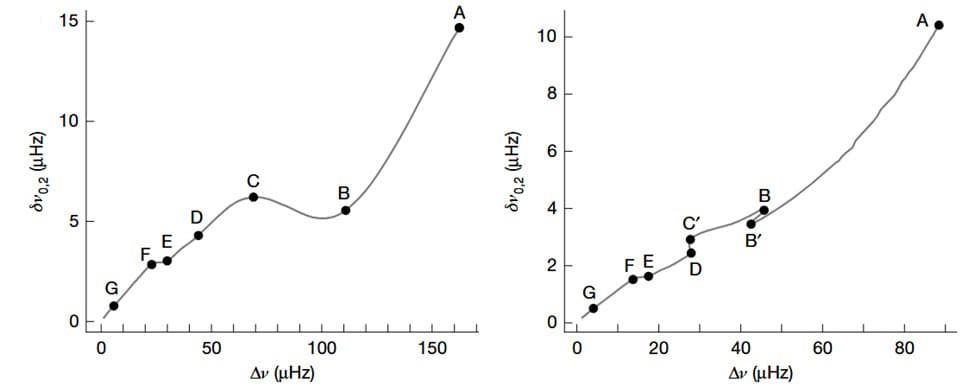Stars are cosmic musical instruments: they vibrate with complex patterns that echo through their interiors. These vibrations, known as pressure waves, ripple through the star, similar to the earthquakes that shake our planet. The frequencies of these waves hold information about the star’s mass, age and internal structure.
In a study led by researchers at UNSW Sydney, Australia, astronomer Claudia Reyes and colleagues “listened” to the sound from stars in the M67 cluster and discovered a surprising feature: a plateau in their frequency pattern. This plateau appears during the subgiant and red giant phases of stars where they expand and evolve after exhausting the hydrogen fuel in their cores. This feature, reported in Nature, reveals how deep the outer layers of the star have pushed into the interior and offers a new diagnostic to improve mass and age estimates of stars beyond the main sequence (the core-hydrogen-burning phase).
How do stars create sound?
Beneath the surface of stars, hot gases are constantly rising, cooling and sinking back down, much like hot bubbles in boiling water. This constant churning is called convection. As these rising and sinking gas blobs collide or burst at the stellar surface, they generate pressure waves. These are essentially acoustic waves, bouncing within the stellar interior to create standing wave patterns.
Stars do not vibrate at just one frequency; they oscillate simultaneously at multiple frequencies, producing a spectrum of sounds. These acoustic oscillations cannot be heard in space directly, but are observed as tiny fluctuations in the star’s brightness over time.
M67 cluster as stellar laboratory
Star clusters offer an ideal environment in which to study stellar evolution as all stars in a cluster form from the same gas cloud at about the same time with the same chemical compositions but with different masses. The researchers investigated stars from the open cluster M67, as this cluster has a rich population of evolved stars including subgiants and red giants with a chemical composition similar to the Sun’s. They measured acoustic oscillations in 27 stars using data from NASA’s Kepler/K2 mission.
Stars oscillate across a range of tones, and in this study the researchers focused on two key features in this oscillation spectrum: large and small frequency separations. The large frequency separation, which probes stellar density, is the frequency difference between oscillations of the same angular degree (ℓ) but different radial orders (n). The small frequency separation refers to frequency differences between the modes of degrees ℓ and ℓ + 2, of consecutive orders of n. For main sequence stars, small separations are reliable age indicators because their changes during hydrogen burning are well understood. In later stages of stellar evolution, however, their relationship to the stellar interior remained unclear.
In 27 stars, Reyes and colleagues investigated the small separation between modes of degrees 0 and 2. Plotting a graph of small versus large frequency separations for each star, called a C–D diagram, they uncovered a surprising plateau in small frequency separations.

The researchers traced this plateau to the evolution of the lower boundary of the star’s convective envelope. As the envelope expands and cools, this boundary sinks deeper into the interior. Along this boundary, the density and sound speed change rapidly due to the difference in chemical composition on either side. These steep changes cause acoustic glitches that disturb how the pressure waves move through the star and temporarily stall the evolution of the small frequency separations, observed as a plateau in the frequency pattern.
This stalling occurs at a specific stage in stellar evolution – when the convective envelope deepens enough to encompass nearly 80% of the star’s mass. To confirm this connection, the researchers varied the amount of convective boundary mixing in their stellar models. They found that the depth of the envelope directly influenced both the timing and shape of the plateau in the small separations.
A new window on galactic history
This plateau serves as a new diagnostic tool to identify a specific evolutionary stage in red giant stars and improve estimates of their mass and age.
“The discovery of the ‘plateau’ frequencies is significant because it represents one more corroboration of the accuracy of our stellar models, as it shows how the turbulent regions at the bottom of a star’s envelope affect the sound speed,” explains Reyes, who is now at the Australian National University in Canberra. “They also have great potential to help determine with ease and great accuracy the mass and age of a star, which is of great interest for galactic archaeology, the study of the history of our galaxy.”
The sounds of starquakes offer a new window to study the evolution of stars and, in turn, recreate the history of our galaxy. Clusters like M67 serve as benchmarks to study and test stellar models and understand the future evolution of stars like our Sun.
“We plan to look for stars in the field which have very well-determined masses and which are in their ‘plateau’ phase,” says Reyes. “We will use these stars to benchmark the diagnostic potential of the plateau frequencies as a tool, so it can later be applied to stars all over the galaxy.”
The post New analysis of M67 cluster helps decode the sound of stars appeared first on Physics World.

